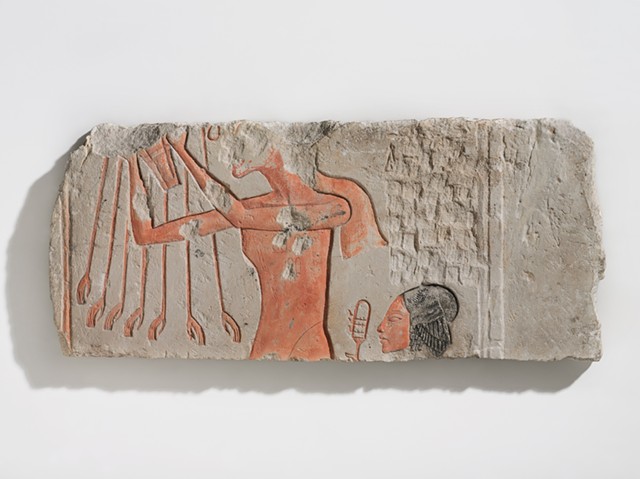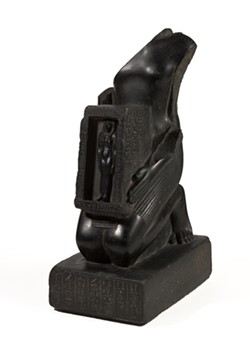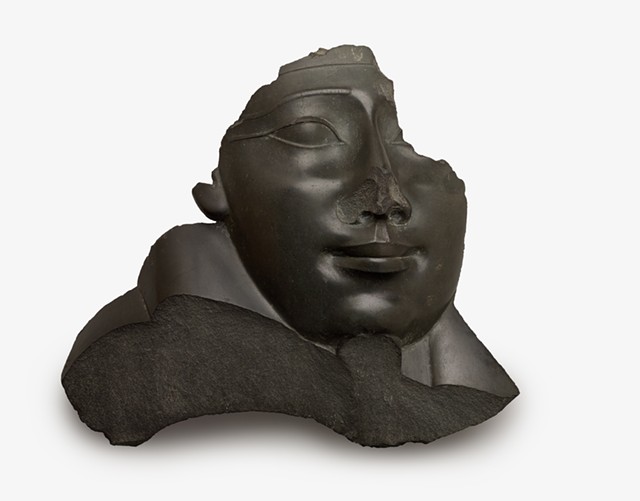
- PHOTO COURTESY BROOKLYN MUSEUM
- An object labeled "Akhenaten and His Daughter Offering to the Aten" is an example of iconoclasm in ancient Egypt, and is part of an exhibit organized by the Brooklyn Museum on view at the Memorial Art Gallery. Akhenaten made drastic changes to how religion was allowed to be practiced during his lifetime, decisions that were reversed after his death. Vandals used a chisel on this image to destroy the pharaoh's identity and ability to make offerings to the god.
An exhibit of ancient Egyptian artifacts is on view at the Memorial Art Gallery, but it’s not your typical display of mummified remains, sarcophagi, and jewels.
It’s called “Striking Power: Iconoclasm in Ancient Egypt,” and it spotlights the common ancient Egyptian practice of destroying the features on statues and images of pharaohs and other historic figures. This exhibition explores the reasons behind that destruction — like striking a political opponent’s legacy from the record or preventing the dead from coming for you.
Say a grave robber desecrated a tomb and stole the occupant’s gold and other goods.
“Well, they're going to make it impossible for the owner of that tomb, for the person who inhabits that tomb to seek revenge, by killing them again,” said the MAG’s Nancy Norwood, who is presenting curator for the exhibit.
That’s accomplished, she said, by destroying specific features on statues and images of the occupant, disrupting the images’ potency.
“Striking Power” was organized by Edward Bleiberg, curator emeritus at the Brooklyn Museum, which has one of the most extensive collections of Egyptian artifacts in the United States.
Posted to the title wall of the MAG’s Docent Gallery is the jumping off point for the exhibition and a question that Bleiberg frequently hears from visitors to the Brooklyn Museum: “Why are noses broken on Egyptian statues?”

- PHOTO COURTESY BROOKLYN MUSEUM
- A basalt object labeled "Temple Statue of Pawerem, Priest of Bastet" with its head removed. Curatorial info states this statue was most likely damaged after the 4th century, when there were often attacks on temple statues to disable their pre-Christian purpose.
That’s certainly true of some objects. The show includes examples of artifacts that have been damaged by natural causes over time, such an object labeled “Kneeling Statue of Khaemhat Holding a Stela,” a headless figure carved from hard black granite with fissures running throughout its form. According to a curatorial caption, scientific analysis has shown that the damage was not intentional, but caused by water.
There are also cases where statues were damaged so the stones could be reused for building projects, not to control the images’ power.
But there is a discernible pattern in which features are damaged in this practice of iconoclasm that was carried out across many dynasties. In addition to noses being broken off, eyes are chiseled out. Hands and arms are severed at the elbow or wrist. Where names once existed in hieroglyphs, they have been chipped off, leaving deep scars in once intricately-carved stone.
A career Egyptologist, Bleiberg knows all about Egyptian funerary practices and beliefs about the afterlife — that ancient Egyptians believed that both the body and the spirit continued on after death. But that body still needed nourishment, and that spirit still needed the good graces of the gods.
“If, say, someone broke your nose, you could no longer breathe,” Norwood said. “If someone broke your hand, the hand that is responsible for offerings, you could no longer offer to the gods. And if someone broke your hand that you would feed yourself with, you could no longer have nutrients in the afterlife.”
Norwood said that in some cases, the destruction was a way of striking political opponents from the record.

- PHOTO COURTESY BROOKLYN MUSEUM
- The nose is destroyed on a basalt face and shoulder from an Anthropoid sarcophagus, and the beard of Osiris — a marker of royalty and divinity — has been removed.
Out of a few examples of attempted erasure, a granite object labeled “Head of Hatshepsut” is perhaps the most egregious. Her nose is broken off and the eyes are marred by chisel marks, but the vandals went further. The statue, once adorned with a crowning cobra, king’s beard, and the body of a sphinx — all symbols of royalty and divinity — is so mutilated that only the head remains.
“So you've taken away not only her ability to exist, or to breathe, you've also taken away any of the royal trappings that made her a pharaoh,” Norwood said.
This ancient power play is still in practice. Iconoclasm is committed in contemporary culture as political footholds shift around the world — one of the most dramatic modern instances occurred in March of 2001 when the Taliban blew up two sixth-century monumental Buddha statues carved into the Bamyan cliffs in Afghanistan, after the Taliban government declared they were idols.
It’s worth noting that there’s a widely-repeated belief that the destruction of facial features on ancient Egyptian statues was done by European cultures in order to erase evidence of African-featured rulers in the ancient world.
Though this isn’t the focus of the exhibit, “Striking Power” creator Bleiberg discussed the matter briefly during the talk he gave when the show opened at the MAG in Nov. 2022. At the beginning of the talk he explored what he called the “insidious and ludicrous” ideas of Samuel George Morton, who in 1844 published Crania Aegyptiaca, a book that claimed the ruling classes in ancient Egypt were white and the servant classes were African, allegedly based on the cranial anatomy of their remains. The racist idea was reinforced by 19th century exhibitions that erroneously displayed white-featured recreations of pharaohs alongside their broken statues.
“Museums were indeed complicit in this idea of a white ruling class and a Black working class in ancient Egypt,” Bleiberg said. “This is not what Egyptologists are taught today, but that message very rarely gets out to the public in general.”
“Striking Power: Iconoclasm in Ancient Egypt” continues through March 5 and includes dozens of ancient objects and interpretive materials, as well as interactive stations for visitors of all ages to dig into during its run. The MAG is open 11 a.m. to 5 p.m. Wednesday through Sunday, Thursdays until 9 p.m. Admission is $14-$25, and free to members, children age 5 and under, SNAP card holders, and some others. Visit mag.rochester.edu for more details.
Rebecca Rafferty is CITY's life editor. She can be reached at [email protected].
